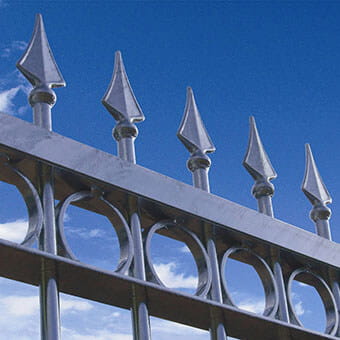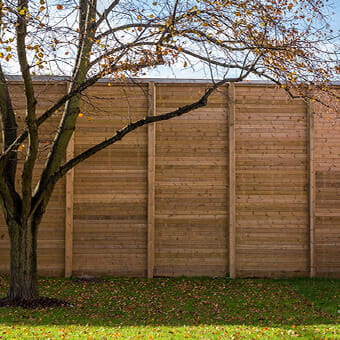Our other sites:
With uses ranging from security to aesthetics, there are a wide variety of security toppings that can be added to fences, such as combs, spikes, flexible security toppings, electric deterrents, and barbed wire. Fence toppings are usually required by sites in need of increased security against climbing, either as a visual deterrent, or physical barrier. Sometimes, the fence itself, if it is the right design, can be enough without an additional topping. If you’re unsure whether fence toppings are right for your premises, see below to find out how they can be an invaluable addition to your security measures.
Types of security toppings
Security Comb
Security Comb is a topping that can be installed on top of fencing like Sentry®, EuroGuard® Combi, or other flat top fence panels including garden fence panels to add extra perimeter protection. Jacksons Security Comb consists of a double row of galvanised metal teeth. Security comb serves as a deterrent against climbing attempts but does not have an overly intimidating appearance. It is best for standard security risks and even domestic properties.
A similar style of topping but with much more intimidating appearances are Viper Spike and Cobra® Spike. Installed in the same way on flat top fences, gates and walls, menacing spikes protrude to create a formidable barrier against intruders.

Rotating Security Toppings
For heightened security needs, rotating toppings like Rota-Spike® and Cobra® Spike Rotary establish a revolving anti-climb barrier which creates an unstable and challenging obstacle for potential climbers. These are commonly used in industrial sites and higher security applications due to their hostile appearance or around high value compounds to protect against even determined intruders.
.jpg?h=450&w=600&hash=AB1EF3D6A9CF90448C784B5C7F978FEE)
Barbed Tape and Wire
Barbed wire and barbed tape are a timeless and cost-effective security topping that increase perimeter security and protection against climbing over fencing. They serve as both a physical barrier and a psychological deterrent, discouraging unauthorised access, but they are the most basic form of security topping. There are various styles, including concertina and flat wrap, both of which are highly difficult to climb and visually imposing.

Electric Deterrents
Electric deterrents are another option for enhancing fence security. These systems deliver a non-lethal electric shock upon contact, serving as a strong deterrent against intrusion. It's essential to ensure that such systems comply with local regulations and are installed by qualified professionals.
Flexible Security Toppings
Flexible security toppings are made of mesh fixed to a flexible steel bracket that is designed to move when people attempt to climb it, but without collapsing. They are commonly used around prisons.

Cranked Fence Toppings
Cranked fence toppings are similar to flexible security toppings and are designed to extend the height and security of a fence by angling outward, typically at 45 or 90 degrees. These are often made from metal mesh or barbed wire and serve as an effective deterrent against climbing, as they make scaling the fence significantly more difficult.
Fencing without security toppings/anti-climb fence designs
Some fencing styles have a security topping built into them, like Barbican® Barbed Top and Barbican Defender® Xtreme. The latter has a cranked topping built in, while Barbican® Barbed Top adds a spike to each pale.
Barbican Defender is often installed around heritage sites, castles, and landmarks, providing strong anti-climb security while blending seamlessly with the site's aesthetics.
For high-security yet visually appropriate protection, Barbican® Extra and Barbed Top serve as an excellent deterrent. They effectively prevent climbing without appearing overly industrial, making them popular choices for car compounds, train stations, and other public-facing areas requiring strong anti-climb measures.
Some anti-climb fencing styles are also used to maintain brand consistency across multiple depots. A great example is Champion Timber, which has installed Tri-Guard® fencing across several of its locations to create a uniform and professional appearance.
If the goal is to increase protection against climbing but in a subtle way without displaying hostility, considering the height and the design of the fence is sometimes all you need. Take a look at our anti-climb fencing for products which are naturally designed to protect against climbing.

Reasons for installing security toppings
Aesthetics
Each style of fence topping makes a different impression; some are designed to deter while others are designed to add a further level of security to a property. Security toppings send a message not only to potential intruders, but also to prospective visitors about the safety of the premises, which can be an attractive quality.
Deterrence and Intimidation
Deterrence is the first layer of the 5 Ds of perimeter security and can dissuade potential intruders from targeting a property. Deterrents should be visible and fence toppings accompanied by warning signs are a great way of achieving this.
Toppings that have sharp angles, spikes or an added overlay are hugely discouraging for many intruders and can be used alone or in conjunction with other deterrent measures such as CCTV and Perimeter Intruder Detection Systems (PIDS), depending on your security needs. As well as the threat of injury to put off potential criminals, spikes make it clear the site has a practical and considered security plan in place and can also hold people within a perimeter, discouraging escape.
Preventing Scaling
The inconvenience and possibility of injury associated with security toppings are often all that’s needed to prevent intruders from scaling perimeter fencing, but a secure perimeter should always be clear of any step-ups that might make scaling and intrusion easier, for example trees and bins.
High-value and High-Risk Sites
The fence security topping best suited to your site depends on your specific security needs. For example, storing high-value contents on your site may determine the kind of intruders you can expect and, as such, the deterrents and measures to put in place. Sites located in high risk areas might also be more vulnerable to intrusion. For extra security, consider security toppings along with a tall, anti-climb fence.
Safety regulations around fence toppings
Shorter Height Fences
Although rules vary regarding the height a fence must be in order to install security toppings, they should generally not be installed on any fences under 2m to prevent members of the public being accidentally injured by the toppings and should always be installed with the appropriate signage and warnings.
Warning Signs
Fence security toppings should be accompanied by warning signs stating the risks they present to limit your liability in the case of injury during intrusion (provided that the danger is visible). To ensure you’re compliant with the law, place warning signs all along your perimeter fencing where security topping is used, every 8-10m and make sure you’re familiar with the Occupier’s Liability Act 1984 and the Occupier’s Liability Act 1957.
Effective toppings are invaluable additions particularly for high value sites. Make sure that whatever you decide to use that you are familiar with any laws or regulations relevant to fencing and toppings. To find out more about our fence toppings, click here.
Related products
Jacksons Security has a range of products relating to this article, all complete with our 25 year service life guarantee. If you cannot find the item you are looking for, please do not hesitate to call our friendly sales team.
Related Content
Top






